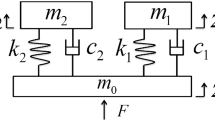Abstract
This study is based on previously developed tools for car seat designers. A simplified modeling approach to predict the vibration response, about an operating point, of mannequin occupied car seats is demonstrated to be feasible. A two-dimensional model, consisting of rigid bodies interconnected by pin joints with torsional dampers, springs and dampers had been developed. The springs and dampers are linear and the nonlinearity in the model is due to geometric effects, although at vibration levels experienced under normal driving conditions a linearized version of the model predicts responses. The effects of changing model parameters on the natural frequencies, the mode shapes and resonance locations in frequency response functions were shown in previous papers. Reasonable qualitative as well as good quantitative agreement between experimental and simulation frequency response estimates is obtained. Especially, k2 parameter, x-directional excitation and matching between the experiment and simulation are considered. The application of these simplified models is in car seat design, where they would facilitate evaluation of the effects of seat design changes prior to prototyping.
Similar content being viewed by others
References
Nishiyama, S., Takeda, F. and Takeshima, T., “Influences of sitting posture on vibration characteristics of the human body (experimental investigation),” Transactions of the Japan Society of Mechanical Engineers. C, Vol. 61, No. 590, pp. 3866–3873, 1995.
Nishiyama, S., “Development of simulation system on vehicle-occupant dynamic interaction (1st Report, Theoretical analysis and system verification),” Transactions of the Japan Society of Mechanical Engineers. C, Vol. 59, No. 568, pp. 3613–3621, 1993.
Nishiyama, S., “Development of simulation system on vehicle-occupant dynamic interaction (3rd Report, Influence of parameters of occupant-seat system on human comfort),” Transactions of the Japan Society of Mechanical Engineers. C, Vol. 60, No. 573, pp. 1509–1516, 1994.
Nishiyama, S., “Vertical and lateral vibration analysis of vehicle-occupant dynamic interaction with simulation system,” Transactions of the Japan Society of Mechanical Engineers. C, Vol. 59, No. 567, pp. 3239–3246, 1993.
White, S. W., “Dynamic modeling and measurement of occupied seats and seating foam,” Master Thesis, School of Mechanical Engineering, Purdue University, 1998.
White, S. W., Kim, S. K., Davies, P., Bajaj, A. K., Liedtke, P. E. and Showers, D. K., “Modeling and measurement of occupied car seats,” SAE Noise and Vibration Conference and Exposition, Document No. 1999-01-1690, 1999.
Amirouche, F. M. L., Xie, M. and Patwardhan, A., “Optimization of the contact damping and stiffness coefficients to minimize human body vibration,” Journal of Biomechanical Engineering, Vol. 116, No. 4, pp. 413–420, 1994.
Demic, M., “Optimization of vehicles elasto-damping elements characteristics from the aspect of ride comfort,” Vehicle System Dynamics, Vol. 23, No. 1, pp. 351–377, 1994.
Berger, E. and Gilmore, B. J., “Seat dynamic parameters for ride quality,” SAE International Journal of Passenger Cars, Vol. 102, No. 8, pp. 204–217, 1993.
Wan, Y. and Schimmels, J. M., “Optimal seat suspension design based on minimum simulated subjective response,” Journal of Biomedical Engineering, Vol. 119, No. 4, pp. 409–416, 1997.
Boileau, P. E., Rakheja, S., Yang, X. and Stiharu, I., “Comparison of biodynamic response characteristics of various human body models as applied to seated vehicle drivers,” Noise and Vibration Worldwide, Vol. 28, No. 9, pp. 7–15, 1997.
Patten, W. N. and Pang, J., “Validation of a nonlinear automotive seat cushion vibration model,” Vehicle System Dynamics, Vol. 30, No. 1, pp. 55–68, 1998.
Mansfied, N. J. and Griffin, M. J., “Non-linearities in apparent mass and transmissibility during exposure to whole-body vertical vibration,” Journal of Biomechanics, Vol. 33, No. 8, pp. 933–941, 2000.
Kim, H. J. and Choe, E. J., “Analysis of Optimal Dynamic Absorbing System considering Human Behavior induced by Transmitted Force,” International Journal of the Korean Society Precision Engineering, Vol. 4, No. 6, pp. 38–43, 2003.
Jo, H. C. and Kim, Y. E., “A study on the influence of the seat and head restraint foam stiffnesses on neck injury in low speed offset rear impacts,” Int. J. Precis. Eng. Manuf., Vol. 10, No. 2, pp. 105–110, 2009.
Author information
Authors and Affiliations
Corresponding author
Rights and permissions
About this article
Cite this article
Kim, S.K. Simulations of the vibration response of mannequins in car seats by changing parameter and excitation. Int. J. Precis. Eng. Manuf. 11, 285–289 (2010). https://doi.org/10.1007/s12541-010-0032-1
Received:
Accepted:
Published:
Issue Date:
DOI: https://doi.org/10.1007/s12541-010-0032-1




